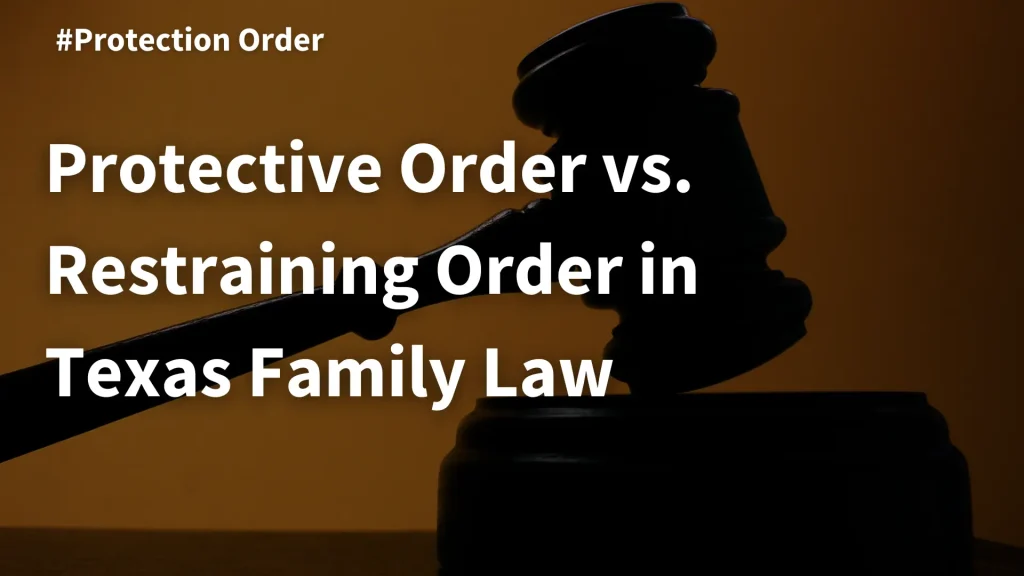 :There may come a time when an individual needs to apply for legal protection against another person to prevent harm or harassment. Two of the most common legal tools available for this purpose in Texas are protective orders and restraining orders. Understanding “protective order vs. restraining order” differences is critical for anyone facing a situation that may require legal intervention.
:There may come a time when an individual needs to apply for legal protection against another person to prevent harm or harassment. Two of the most common legal tools available for this purpose in Texas are protective orders and restraining orders. Understanding “protective order vs. restraining order” differences is critical for anyone facing a situation that may require legal intervention.
What is a Protective Order?
A protective order in Texas is a legal directive issued by a court to prevent acts of violence, harassment, or stalking. It often applies to situations where an individual feels threatened or has been a victim of any of the following:
- Sexual assault
- Domestic violence
- Other forms of abuse
A Texas protective order provides immediate and long-term protection to victims by legally prohibiting the aggressor from coming into contact with them.
What are the Requirements for Filing?
Not everyone can request a State of Texas protective order. To qualify, the individual seeking protection must have a specific relationship with the aggressor, such as a family member, household member, or someone with whom they have a close dating relationship. The applicant must also provide evidence of recent or ongoing threats or acts of violence. The court will issue a protective order in Texas if it believes that the applicant is in danger and that you need an order to prevent further harm. There are various types of protective orders that a court may issue. These include:
- Temporary Ex Parte Protective Orders – These orders provide immediate protection and last until a judge hears the case in a full court hearing. Courts do not require the presence of the alleged abuser for this type of order.
- Final Protective Orders – Judges provide these orders after a court hearing where both parties present their case. These orders can last up to two years or longer, depending on the circumstances.
- Emergency Protective Orders – A magistrate will generally issue this type of protective order following an arrest for family violence. These orders provide short-term protection until a court hearing occurs.
The duration of a Texas protective order varies depending on the type issued. Temporary orders may last up to 20 days, while final orders can extend up to two years or more. Violating a protective order is a severe offense and can result in criminal charges. This may include potential fines and jail time. Law enforcement is actively involved in enforcing these orders to ensure the safety of the victim.
What is a Restraining Order?
A restraining order in Texas is a legal order that is usually issued to prevent a person from taking specific actions. This may include:
- Disposing of assets
- Harassing another person
- Making contact with specific individuals
While restraining and protective orders might sound similar, their purposes differ. A restraining order is more commonly used in civil cases, such as divorce or child custody disputes, rather than cases involving immediate threats of violence.
Who Qualifies for a Restraining Order?
Anyone involved in a legal dispute, such as a divorce or business disagreement, can request a Texas restraining order. The applicant must demonstrate that the requested actions are necessary to prevent harm, maintain the status quo, or protect their legal rights during the litigation process. Unlike protective orders, restraining orders do not require evidence of violence or threats but the circumstances of the case must still justify one. Types of restraining orders that a court may issue include:
- Temporary Restraining Orders (TROs) – These are short-term orders issued to maintain the status quo until a judge creates a more permanent order. They are often issued without the other party being present.
- Permanent Restraining Orders – Issued after a full court hearing, these orders provide long-term protection and can last for the duration of the legal case or longer.
A restraining order is generally temporary and usually lasts until the court can hold a hearing to decide on a more permanent solution. However, permanent restraining orders can be issued if necessary. While violating a restraining order can lead to legal penalties, including fines and imprisonment, the enforcement is not usually as harsh as a protective order. This is because restraining orders are civil in nature rather than criminal.
Court Hearings and Evidence
Both protective orders and restraining orders require a court hearing to assess their validity and ensure justice is served. During these hearings, the judge carefully considers the evidence presented by both parties involved and weighs the merits of each side’s claims.
In the case of a protective order, the evidence may include a variety of documents and testimonies, such as police reports detailing incidents of threats or violence, medical records showing injuries sustained, and witness testimony from individuals who can corroborate the claimant’s experience.
On the other hand, legal disputes, such as divorce or custody cases, often call for a restraining order, where one party seeks to restrict the other’s actions. The evidence presented in these cases often includes essential documents related to the legal dispute, including financial statements that outline assets and liabilities and communications between the parties, like emails or text messages that may demonstrate threatening or harassing behavior. The court’s thorough examination of this evidence is crucial in determining the outcome of the orders and ensuring the protection of those involved.
Seeking Legal Help

- Gather the evidence you need to support your request
- Represent your interests in court
- Determine whether you need a restraining order vs an order of protection
Contact an Austin Family Law Attorney Today
Consulting with a family law attorney is essential in deciding which type of order to pursue. An attorney can assess your situation and advise you on the best course of action. Your lawyer can help you apply for the appropriate protection. Understanding the difference between a restraining order vs order of protection can significantly impact the outcome of your case.
Call our Austin family law attorneys at Smith Family Law. You can also contact us online to get started with a case evaluation. Whether you need a protective order or a restraining order, our experienced attorneys are here to help you through the legal process and protect your rights.